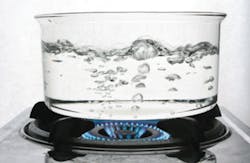Editor’s note: This is the continuation of a two-part article from last month. To read part one, click here.
Know the FEMA and Red Cross recommendations
The Federal Emergency Management Agency (FEMA) and the American Red Cross have created a comprehensive document that explains how to treat water during an emergency situation. FEMA recommends three methods for treating water during an emergency situation: Boiling, chlorination and distillation. Water treatment professionals should be well versed in these recommendations and should recommend the document to clients. Every home in the U.S. should have a copy of this pamphlet printed out and stored in a safe place for reference if the power goes out. Download this document at http://www.fema.gov/pdf/library/f&web.pdf for free.
Understand the science behind the FEMA and Red Cross recommendations
It is not enough to know what FEMA and the Red Cross recommend. It is also important to understand why these recommendations are in place. Only by understanding the science behind the recommendations can people understand how to prioritize water concerns and how to properly use the tools that they have. When things go wrong, people have to be able to adjust to real-world conditions and this means that they need a higher level of understanding. This information can be presented in a simple and straightforward way that average people can understand.
The following information needs to be conveyed in as simple terms as possible:
- During an emergency situation, such as a hurricane or an earthquake, the water coming from your tap can become dangerously contaminated without your knowledge, or it may stop flowing all together. You may not know whether your water is contaminated or not, so take precautions.
- Having a supply of safe and clean drinking water is vital to your family’s safety. It is at the top of the list and is more important than food.
- Water safety and cleanliness is the only priority as it pertains to water. Do not get distracted with concepts such as alkaline, structured or clustered water, or anything else.
- There are five primary categories of contaminants that can be in water: Particulates, biological, inorganic, radioactive and organic. Biological contaminants, including bacteria, parasites and viruses, are usually much more dangerous than the other types of contaminants. The difference is significant. Biological contaminants can make you ill or can even cause death within hours or days.
- While most people have experienced a stomach bug, in our day-to-day lives a stomach bug is usually just an inconvenience. We drink plenty of water and get plenty of sleep and we get better. But, when you are unable to drink plenty of water, such an illness can quickly become dangerous and incapacitating.
- It is important to understand that FEMA and the Red Cross recommend boiling, chlorination and distillation as the core methods for treating water during an emergency because of their concern over biological contaminants. There is no room for error when it comes to biological contaminants, especially during an emergency situation. This emphasis on protection from biological contaminants is very important.
- This emphasis on biological contaminants is the reason filters are not recommended by FEMA and the Red Cross as a core method for treating water during an emergency. Filters provide variable protection and should be used only on potable water. Filters, including reverse osmosis filters, can become a breeding ground for bacteria. When filters fail, contaminants can pass through to the filtered water without your knowledge. There is a proper way to use filters, however, which we will get to.
- Also not mentioned are ultraviolet (UV) lights and ozone, which cannot be counted on to produce the highest level of protection against dangerously contaminated water, especially if the power goes out. FEMA and the Red Cross specifically say to not use any chemicals other than chlorine.
- You are able to exceed the FEMA/Red Cross recommendations if you take the correct steps. While biological contaminants are the most dangerous, other types of contaminants can also be very dangerous and can be released into the environment in large quantities during an earthquake or hurricane. You should understand the proper priorities: Priority No. 1 is absolute protection against biological contaminants. Priority No. 2 should be protection against all other types of contaminants, as long as Priority No. 2 does not interfere with Priority No. 1.
- When looked at in this way, we can further analyze the FEMA-recommended methods for treating water. Boiling water is an excellent method for killing biological contaminants in water, but boiling water does not remove biological contaminants or endotoxins created when biological contaminants die, and boiling can actually concentrate other contaminants such as heavy metals. Chlorination also kills biological contaminants in water but does nothing to remove dead biological contaminants or other contaminants. Again, even though the process of boiling water may concentrate other contaminants, its effectiveness against biological contaminants makes it an essential treatment method.
- Distillation, which is the process of boiling water and then capturing the pure steam and condensing it back into liquid water, is the only process recommended by FEMA and the Red Cross that kills and removes biological contaminants, while also protecting against a broad-spectrum of other contaminants. Distillation provides high-purity drinking water for as long as needed and can be a permanent method for desalinating ocean water. Distillation requires fuel, such as propane or a wood fire.
Know what to recommend and what not to recommend
So, what should you recommend? Everyone should have at least a two-week supply of bottled water. Beyond this, however, everyone should have a means to boil water and should have bleach on hand so they can disinfect water. Ideally, a person should have an emergency water distiller stored away because this will provide the highest level of protection and is the only method that allows people to convert ocean water into pure drinking water. There are two leading emergency water distillers on the market today. While filters should not be used as a primary treatment method during an emergency, filters can be effective at removing some contaminants prior to using one of the FEMA/ Red Cross recommended methods. For example, you can filter water and then boil or chlorinate the water, but you must know that the FEMA/ Red Cross recommended methods should always be used as the final step in treating the water. Do not boil water, for example, and then filter it because the filter could re-contaminate the water.
Understand the tools that are available to you
There are three primary tools available to educate people about the proper way to treat water during an emergency. First, the FEMA/ Red Cross pamphlet located at fema.gov/pdf/library/f&web.pdf. Second, at WaterInAnEmergency.com you can download a free e-book called, "Understanding FEMA & Red Cross Recommendations for Treating Water in an Emergency." People should print this e-book out and store it in a safe location. Not only is this e-book free, but it can be distributed to anyone. Third, also at WaterInAnEmergency.com, people can purchase a laminated quick-reference guide that provides a condensed resource for information on how to ensure a supply of safe drinking water during an emergency. This should be stored with an emergency kit.
Educate your clients and take a leadership role
On a final note, I want to emphasize that by doing some education you can make a significant impact on people’s lives. This education, however, needs to take place before an emergency happens. Afterwards is simply too late. Blog about it. Talk about it. Encourage people to download the FEMA brochure, or email the e-book mentioned above. Reach out to local emergency management agencies and city councils. Take a leadership role in your local community. Beyond this, I encourage the water treatment industry to develop training materials for water treatment professionals.
Glenn Meder is the president of GAEMRIC Inc. and is the inventor of the Survival Still, emergency drinking water system (www.SurvivalStill.com). Glenn has worked in the water distillation industry for over 20 years and has written an e-book called, "Understanding FEMA & Red Cross Recommendations for Treating Water in an Emergency," which can be downloaded for free at WaterInAnEmergency.com.


